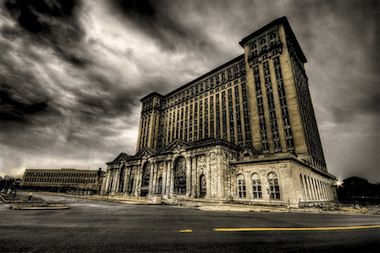
The poster child for Detroit’s decline is the old Michigan Central Railroad Station (pictured below). Tourists trek from overseas to photograph this derelict building, a once-grand 15-story structure that stands stripped like an abandoned car, as perforated as a soiled and tattered IBM punch card. To see it is to disbelieve it.
You may never have been to Detroit, and you’ve probably read your fill about its bankruptcy. My wife was born there, and over the past 30 years, I’ve visited there at least two dozen times. On all but three or four of those trips, I’ve only seen the suburbs. They look like prosperous suburbs anywhere, only flatter.
The city of Detroit is a different story altogether. It’s a ghost metropolis. Yes, there’s a new baseball stadium, an open air farmers market, a restored Fox Theatre (an original “picture palace”), a zoo and, of course, casinos. There are also minor signs of gentrification by hip young urban homesteaders. But these isolated nodes of activity, criss-crossed by concrete expressways, dot an otherwise devastated landscape of abandoned schools, empty factories and boarded-up homes.
 Detroit, not unlike parts of Baltimore and Philadelphia and many smaller Rustbelt cities, isn’t so much a failed city as an abandoned one. As people, jobs and businesses have streamed to the suburbs or the Sunbelt, revenues from income tax and property tax have plummeted. The financial crisis was a coup de grace, reducing the value of Detroit’s pension assets by over $1 billion.
Detroit, not unlike parts of Baltimore and Philadelphia and many smaller Rustbelt cities, isn’t so much a failed city as an abandoned one. As people, jobs and businesses have streamed to the suburbs or the Sunbelt, revenues from income tax and property tax have plummeted. The financial crisis was a coup de grace, reducing the value of Detroit’s pension assets by over $1 billion.
When Detroit’s emergency manager filed for Chapter 9 bankruptcy recently, the fate of the city’s retirement plans was cast into further doubt. Its underfunding was recalculated upward to $3.5 billion from $640 million. I have tried to understand the pension situation by downloading city documents, and by calling someone I know who I thought might know a lot about the bankruptcy and the pensions. He told an interesting story about one aspect of the pension mess.
In June 2005, according to an audit of the pensions, the city of Detroit, unable to contribute to its pension funds otherwise, borrowed $1.44 billion from European banks in a deal brokered, according to the Wall Street Journal, by UBS and others, who earned $46.4 million in fees. Of the proceeds, $740 million went into the city’s General Retirement System and about $630 million into the Police & Fire Retirement System.
The city did not issue debt, however. “Service corporations” were established by the two pensions to set up a trust to receive future pension contributions from the city. The trust issued 20-year “certificates of participation” (COPs) to the lenders. The city also entered into swap agreements to protect itself and its lenders from interest rate risk.
According to my source—I have not independently confirmed it—the European lenders acted in the belief that Detroit’s obligations were “sovereign.” In the run-up to the financial crisis, sovereign debt, even from shaky governments like Greece, Spain (or, apparently, Detroit) was valued less for its LIBOR yield than for the fact that it required less reserving when it was leveraged—i.e., used as collateral for further borrowing and lending.
The limits of that strategy were exposed by the global financial crisis, and most or all of the lenders failed. The Wall Street Journal reported on July 22 that the COPs lenders included Dexis, a since-nationalized Franco-Belgian lender, Ireland’s Depfa Bank Plc, UBS, and Bank of America. Dow Jones reported that Commerzbank, through its Eurohypo unit, loaned Detroit $400 million, and that the loans are now in a German government-run “bad bank.”
The financial crisis also wiped out a big portion of Detroit’s pension assets. In fiscal 2009, the city’s General retirement fund lost over $1 billion in value while paying out $270 million in benefits. It will never recover. From June 30, 2008 to June 30, 2009, the investment income of the General fund (which has about only about 6,200 active participants and 11,800 retirees) went from a $614.3 million gain (on $3.42 billion in assets) to a $794.7 million loss. Assets fell to $2.25 billion, a decline of over $1 billion.
Since then, payouts have overwhelmed investment revenue and contributions. Benefits have steadily risen, from $271 million in FY 2008 to $387 million in FY 2012, which included a huge third-quarter equities market drop. Assets at the end of FY 2012 were still under $2.2 billion, and assets fell by almost $263 million. In its Proposal for Creditors, released on June 14, the Emergency Manager said the city won’t be making its $50 million current-year contribution to the police and fire plan and, in the future, won’t be contributing the estimated $200 million to $350 million a year that it would take to fully fund both pensions, now underfunded by an estimated $3.5 billion.
It’s unclear whether the foreign lenders (or, in most cases, their own receivers) will be able to recover much from Detroit. The value of the COPs has already been written down by as much as half. The certificates are not secured or funded by any particular municipal income stream. (The swap agreements may be funded by gambling fees.) It’s been suggested that the COPs may have been issued improperly in the first place, and that Detroit Emergency Manager Kevyn Orr may try to void them entirely. The June 14 proposal said, somewhat mysteriously, that “the City has identified certain issues related to the validity and/or enforceability of the COPs that may warrant further investigation.” A lawyer for the city declined to comment.
© 2013 RIJ Publishing LLC. All rights reserved.


